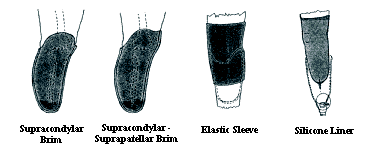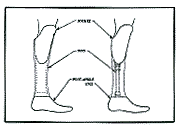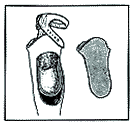

 Most prostheses for amputations between knee and ankle consist of three major parts: a socket, a shank, or shin, and a foot.
Most prostheses for amputations between knee and ankle consist of three major parts: a socket, a shank, or shin, and a foot.
The most common socket used is some form of the Patellar-Tendon-Bearing (PTB) design where all of the weight of the amputee is carried through the stump. The PTB socket totally encloses the stump and usually contains a "soft" liner to provide a cushioning effect, although many amputees prefer a "hard" socket because it is considered to be cooler. The prosthesis may be held in place by any of a number of ways: by a cuff above the knee cap; by the shape of the brim of the socket; or by suction between the socket and amputee produced by an elastic sleeve or flexible inner liner of silicone and attached mechanically to the prosthesis.
Sockets are made of plastic. The shank may be either a hollow shell (crustacean) or a tube (pylon) covered by foam and a flexible outer layer (endoskeletal). The pylon may contain provisions so that alignment may be adjusted at any time during the life of the prosthesis. Any of several types of artificial feet may be used, depending upon the userís preference.

The electronic version of this manual is presented by Dankmeyer, Inc., with the permission of the authors. This manual may not be redistributed in any form.